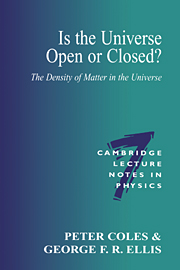7 - The cosmic microwave background
Published online by Cambridge University Press: 25 January 2010
Summary
The detection of fluctuations in the sky temperature of the cosmic microwave background (CMB) by the COBE team (Smoot et al. 1992) was an important milestone in the development of cosmology. Aside from the discovery of the CMB itself, it was probably the most important event in this field since Hubble's discovery of the expansion of the universe in the 1920s (Hubble 1929). The importance of the COBE detection lies in the way these fluctuations are supposed to have been generated, and their relation to the present matter distribution. As we shall explain shortly, the variations in temperature are thought to be associated with density perturbations existing at the epoch trec, when matter and radiation decoupled. If this is the correct interpretation, then we can actually look back directly at the power spectrum of density fluctuations at early times, before it was modified by non-linear evolution and without having to worry about the possible bias of galaxy power spectra.
The search for anisotropies in the CMB has been going on for around 25 years. As the experiments got better and better, and the upper limits placed on the possible anisotropy got lower and lower, theorists concentrated upon constructing models which predicted the smallest possible temperature fluctuations. The baryononly models of the 1970s were discarded primarily because they could not be modified to produce low enough CMB fluctuations. The introduction of dark matter allowed such a reduction and the culmination of this process was the introduction of bias, which reduces the expected temperature fluctuation still further.
- Type
- Chapter
- Information
- Is the Universe Open or Closed?The Density of Matter in the Universe, pp. 149 - 180Publisher: Cambridge University PressPrint publication year: 1997



